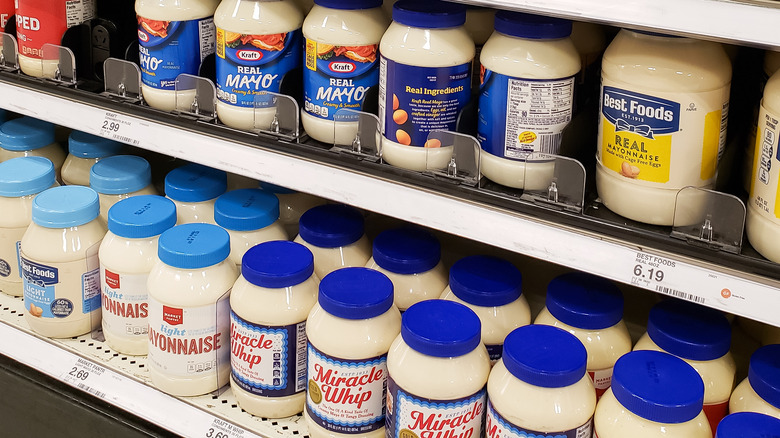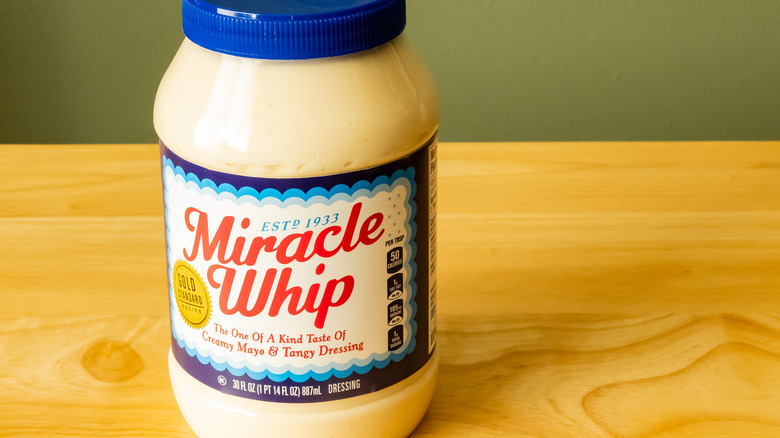What Makes Mayonnaise And Miracle Whip Different?
Few things in life are more polarizing than the Miracle Whip versus mayonnaise debate, per the Huffington Post. Not even Coke versus Pepsi holds a candle. We can't tell you which side is the right side to be on, but we can confirm that Miracle Whip is different in both taste and makeup from other mayonnaise and mayonnaise-style brands.
With a creamy but ever-so-slightly tangy finish, traditional mayonnaise is a truly versatile condiment that can make for the perfect grilled cheese or a juicy and golden roasted turkey. To achieve that distinct taste, most mayonnaise recipes follow a similar structure, and it's so simple you can easily make it yourself. A combination of eggs, oil, and a little bit of acid like vinegar or lemon juice is all it takes to make homemade mayonnaise, but there are often some other ingredients included for additional flavor and differentiation between brands. A hint of dijon mustard is a popular enhancement, or maybe even a sprinkle of sugar.
Many people insist that their tastebuds can tell the difference between varieties, which may be why certain brands have a cult-like following. But what is the real difference between Miracle Whip and the rest of the mayonnaise shelf?
The Miracle Whip secret
Miracle Whip is one of those brands that people feel very strongly about. The hardest fact to swallow here — and possibly the thing that most sets it apart — may be that Miracle Whip isn't technically considered mayonnaise. Yep, you read that right. For the sake of comparison, we are going to treat it as such because it is used just the same way as "true" mayonnaise brands, but when it comes to FDA guidelines, it has less than the required 65% vegetable oil requirement to be considered a mayo, and as such it falls under the "dressing" category.
Because of this, a big thing that makes Miracle Whip different from, say, Hellmann's or Duke's mayo is the lower fat content due to the fact that it contains less oil. This makes Miracle Whip popular among calorie-counters because it gives the same (or maybe slightly sweeter) taste and functionality as other mayo brands with a fraction of the calories. But what it lacks in fat, it makes up for in processed sugar, says Healthline. Miracle Whip is sweetened with high fructose corn syrup, whereas Hellmann's or other brands tend to use real sugar. Miracle Whip also has a higher sugar content in general than most other mayonnaise brands, as well as more added ingredients and spices, but this just may be what some people like about it.
Can you use Miracle Whip and mayonnaise the same way?
Even though Miracle Whip has a dirty little secret when it comes to where you'll find it in the grocery store, it's still used in most of the same ways as its condiments-in-law. Despite subtle differences between brands, mayonnaise itself is an extremely versatile kitchen staple. And it's good for way more than a turkey sandwich or potato salad, although those are perfectly tasty.
The next time you grill up a steak, consider brushing it with a bit of your favorite mayonnaise. The fat in the mayo will act similar to butter and help to add a bit of decadence to the meat as well as lock in flavor and moisture. You can also try slathering it on a chicken or turkey the next time you're grilling or roasting one up, for a nice golden brown skin and a juicy bird. Or how about some jumbo lump crab cakes, made all the more creamy and delicious with your favorite mayo?
While both will function just fine, depending on what you like, Miracle Whip or traditional mayo might have the edge in any of these applications. If you like a steak slathered with more of the richness that a higher fat content provides, mayo might be your new go-to. But if you want to compliment your savory dish with a bit of spicy sweetness, Miracle Whip could just become your secret ingredient.


